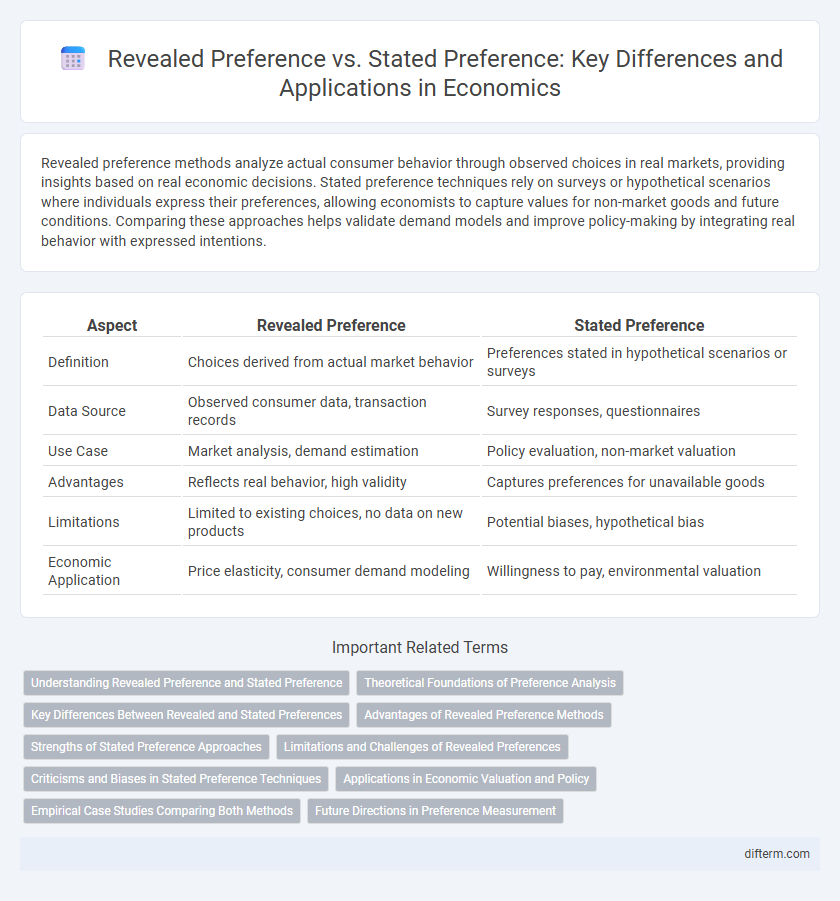Revealed preference methods analyze actual consumer behavior through observed choices in real markets, providing insights based on real economic decisions. Stated preference techniques rely on surveys or hypothetical scenarios where individuals express their preferences, allowing economists to capture values for non-market goods and future conditions. Comparing these approaches helps validate demand models and improve policy-making by integrating real behavior with expressed intentions.
Table of Comparison
| Aspect | Revealed Preference | Stated Preference |
|---|---|---|
| Definition | Choices derived from actual market behavior | Preferences stated in hypothetical scenarios or surveys |
| Data Source | Observed consumer data, transaction records | Survey responses, questionnaires |
| Use Case | Market analysis, demand estimation | Policy evaluation, non-market valuation |
| Advantages | Reflects real behavior, high validity | Captures preferences for unavailable goods |
| Limitations | Limited to existing choices, no data on new products | Potential biases, hypothetical bias |
| Economic Application | Price elasticity, consumer demand modeling | Willingness to pay, environmental valuation |
Understanding Revealed Preference and Stated Preference
Revealed preference analyzes actual consumer behavior by examining choices made in real market situations, reflecting true economic trade-offs and constraints. Stated preference involves surveys or hypothetical scenarios to capture individual valuations and preferences that may not yet be revealed through market actions. Combining these methods enhances demand forecasting and policy evaluation by leveraging observed behavior and stated intentions for comprehensive economic analysis.
Theoretical Foundations of Preference Analysis
Revealed Preference theory relies on observed consumer choices in actual market conditions to infer utility and demand functions, assuming rational behavior and consistent preferences. Stated Preference methods gather data through surveys or experiments where individuals declare their preferences for hypothetical scenarios, addressing limitations of market data absence or non-market goods valuation. Both approaches are grounded in utility maximization principles, but revealed preferences emphasize revealed choices, while stated preferences focus on declared intentions, expanding the scope of economic valuation.
Key Differences Between Revealed and Stated Preferences
Revealed preference bases consumer choices on actual behavior and market data, providing insights from real-world decisions, while stated preference derives from survey responses reflecting hypothetical scenarios and future intentions. Revealed preference typically offers higher accuracy and reliability due to its empirical nature, contrasting with stated preference which captures subjective preferences but may suffer from hypothetical bias or social desirability effects. This distinction impacts economic modeling and policy analysis, where revealed preference results support demand estimation and market predictions, and stated preference aids in valuing non-market goods like environmental benefits.
Advantages of Revealed Preference Methods
Revealed Preference methods leverage actual consumer behavior data, providing more reliable and accurate insights into real-world economic decisions compared to hypothetical scenarios. These methods minimize biases associated with self-reported data, such as strategic misreporting or hypothetical bias, enhancing the validity of demand estimation. Analyzing market transactions and choices reveals authentic preferences, which supports robust policy evaluation and forecasting in economic research.
Strengths of Stated Preference Approaches
Stated preference approaches capture individual choices in hypothetical scenarios, providing rich data on consumer preferences that are not observable through market behavior. These methods allow economists to explore the value of non-market goods and externalities by directly eliciting willingness-to-pay measures. Their flexibility enables analysis of hypothetical policies, offering insights into potential economic impacts before implementation.
Limitations and Challenges of Revealed Preferences
Revealed preference methods face limitations such as reliance on actual market behavior, which may not capture hypothetical choices or future preferences. These approaches struggle to account for incomplete information, external influences, and unobserved factors affecting consumer decisions. The absence of data in non-market settings and difficulties in isolating causal relationships often challenge the accuracy and generalizability of revealed preference analysis.
Criticisms and Biases in Stated Preference Techniques
Stated preference techniques often face criticisms for hypothetical bias, where respondents may overstate or understate their true willingness to pay due to the hypothetical nature of surveys. Strategic bias also undermines data quality, as individuals might manipulate responses to influence policy or resource allocation outcomes. Furthermore, information bias emerges when respondents lack full understanding of the scenario, leading to inconsistent or unreliable valuation of economic goods or services.
Applications in Economic Valuation and Policy
Revealed preference methods analyze actual consumer behavior through market data to estimate economic values, providing empirical insights into demand and willingness to pay for goods and services. Stated preference techniques, such as contingent valuation and choice experiments, capture hypothetical choices in non-market environments, crucial for valuing public goods and environmental resources. Integrating both approaches enhances policy decisions by combining observed economic behavior with projected preferences, improving resource allocation and welfare analysis.
Empirical Case Studies Comparing Both Methods
Empirical case studies comparing revealed preference and stated preference methods demonstrate significant differences in data reliability and application scope. Revealed preference approaches analyze actual market behavior, providing robust insights into consumer choices, while stated preference techniques rely on hypothetical scenarios, useful for evaluating non-market goods like environmental benefits. Studies indicate that integrating both methods can enhance policy analysis precision by compensating for limitations inherent in each.
Future Directions in Preference Measurement
Future directions in preference measurement emphasize integrating revealed preference data with advanced behavioral models to enhance predictive accuracy in economic forecasting. Emerging techniques utilize machine learning algorithms to analyze large datasets, capturing subtle consumer choices and improving the realism of preference estimations. Developing hybrid methodologies that combine real-world observed behaviors with hypothetical scenario responses offers robust insights for policymakers and market analysts.
Revealed Preference vs Stated Preference Infographic

 difterm.com
difterm.com